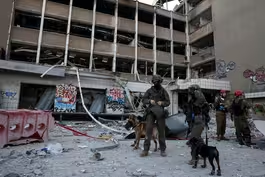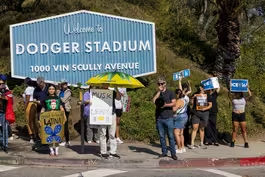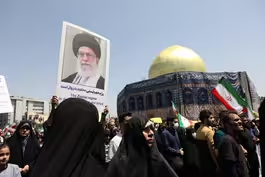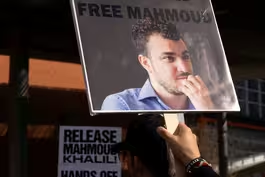
Brutal heatwave blankets much of the U.S.
Clip: 6/20/2025 | 4m 25sVideo has Closed Captions
Brutal heatwave blankets much of the U.S.
Friday is the summer solstice and much of the U.S. is going to be baking in serious heat starting this weekend with a heat dome expected to keep temperatures soaring. Stephanie Sy reports on what you need to know about the days ahead.
Problems playing video? | Closed Captioning Feedback
Problems playing video? | Closed Captioning Feedback
Major corporate funding for the PBS News Hour is provided by BDO, BNSF, Consumer Cellular, American Cruise Lines, and Raymond James. Funding for the PBS NewsHour Weekend is provided by...

Brutal heatwave blankets much of the U.S.
Clip: 6/20/2025 | 4m 25sVideo has Closed Captions
Friday is the summer solstice and much of the U.S. is going to be baking in serious heat starting this weekend with a heat dome expected to keep temperatures soaring. Stephanie Sy reports on what you need to know about the days ahead.
Problems playing video? | Closed Captioning Feedback
How to Watch PBS News Hour
PBS News Hour is available to stream on pbs.org and the free PBS App, available on iPhone, Apple TV, Android TV, Android smartphones, Amazon Fire TV, Amazon Fire Tablet, Roku, Samsung Smart TV, and Vizio.
Providing Support for PBS.org
Learn Moreabout PBS online sponsorshipAMNA NAWAZ: Today is the summer solstice, and much of the country is going to be baking in serious heat starting this weekend.
GEOFF BENNETT: A heat dome is expected to keep temperatures soaring above 90 degrees in many states.
More than 200 million people will feel those effects, and tens of millions more are going to be grappling with triple-digit heat.
Our Stephanie Sy has our look at what you need to know about the days ahead.
STEPHANIE SY: Geoff, here in Phoenix, where the high reached 117 degrees yesterday, triple-digit heat at this time of year is not unusual.
But places like Omaha, Albuquerque and Denver are experiencing temperatures over 100 degrees today.
Looking at the forecast on these maps, you can see how tomorrow, in particular, many parts of the Central Plains and Upper Midwest are in that darker color, meaning dangerous heat.
That's expected to spread to the East Coast in coming days.
Matthew Cappucci is a meteorologist with MyRadar.com, and he joins me now.
Matthew, thanks so much for joining the program.
So, what should we know about this heat wave?
Which parts of the country are going to be hit the hardest?
How long will it last?
MATTHEW CAPPUCCI, Senior Meteorologist, MyRadar: Yes, it's a very expansive, long-duration heat event.
In fact, 220 million Americans will see temperatures over 90, about 35 million Americans seeing triple-digit heat.
And we're not just talking the Desert Southwest.
We're talking to Eastern Seaboard as well.
The heat dome really starts to get established this weekend, Saturday into especially Sunday over parts of the Corn Belt in the Midwest, and then really spreading all the way to the East Coast, lasting until, I'd say, Wednesday or Thursday, before we finally start to see some relief.
Now, we talked about the heat in Arizona moments ago, temperatures nearing 115 degrees.
It's going to be a very long-duration, significant heat event, and I really hope folks are taking precautions ahead of time.
STEPHANIE SY: Yes.
And I'm glad you said that.
We're going to go more in depth into human health effects in a bit, but help us understand what the heat dome is and what's behind it.
MATTHEW CAPPUCCI: Yes.
So we hear this term all the time in the summertime, the so-called heat dome.
And, essentially, heat dome is like this bulge in the atmosphere.
The heat literally expands the atmosphere vertically.
And so picture this force field of hot, dry, sinking air.
It sinks, so it squishes any attempts at rising motion in cloud cover.
And so we're not getting cloud cover, so more sunshine heats the ground, and it almost deflects all the weather systems away.
It's like this hot force field.
So the jet stream is shunted farther north.
It takes the storms with it.
So, really, we get this, like, bubble in the atmosphere where we're just seeing the temperatures bake for days on end with plentiful sunshine.
And it kind of gets stuck in the atmosphere too.
So there's nothing to really move this along until late in the week into, I would say, Friday, Saturday.
STEPHANIE SY: Matthew, how much of these extreme heat waves, heat domes have scientists attributed to climate change versus summer weather patterns that people may have experienced, say, 200 years ago?
MATTHEW CAPPUCCI: I love that distinction you made because, really, it is summertime to your point.
We will see heat domes with or without climate change.
We're always going to see heat events in the summertime.
It'd be weird if we didn't.
But what we're noticing is the scales are tipping more towards hotter heat events and less significant cold events.
So, in other words, the scale is kind of skewing towards more warm events.
They're longer in duration.
They're more intense.
They're more geographically expansive, and this sort of fits that pattern.
It's a fingerprint of climate change.
What we're really noticing too is warm overnight lows.
A warmer atmosphere is a wetter atmosphere, and so we hold more moisture, and that traps temperatures overnight.
And those warm overnight lows really exacerbate heat stress.
Now, there's one point that folks sometimes make that I find very interesting.
A lot of folks say, hey, it was hotter back in the 1930s; 13 states still have all time records that have stood since the 1930s.
And that's true.
But back in the '30s, we had something called the Dust Bowl, where overfarming, inveterate drought, and incredibly hot temperatures combined to lead to this, like, insanely dry air mass that parked over the Plains for the better part of a year.
It's easier to get hot extremes when the temperatures -- or, rather, when the air mass is very dry.
So back then, yes, you might have had warmer temperatures, but you're actually getting more heat energy in the atmosphere nowadays because there's that much more moisture in the air.
So, really, these heat events will continue getting more extreme, and especially the overnight lows are really concerning.
STEPHANIE SY: Matthew Cappucci with Radar.com, thank you so much for those insights, Matthew.
Capehart and Ponnuru on Trump's stance on Iran
Video has Closed Captions
Clip: 6/20/2025 | 11m 17s | Capehart and Ponnuru on Trump's stance on Iran and the rise in political violence (11m 17s)
Carla Hayden on her time as pioneering librarian of Congress
Video has Closed Captions
Clip: 6/20/2025 | 7m 2s | Carla Hayden on her time as a pioneering librarian of Congress and getting fired by Trump (7m 2s)
European leaders meet with Iran's foreign minister
Video has Closed Captions
Clip: 6/20/2025 | 4m 24s | European leaders meet with Iran's foreign minister as war with Israel rages on (4m 24s)
Federal agents are denied access to Dodger Stadium
Video has Closed Captions
Clip: 6/20/2025 | 6m 25s | Federal agents are denied access to Dodger Stadium in latest immigration clash (6m 25s)
How people inside Iran are reacting to the war
Video has Closed Captions
Clip: 6/20/2025 | 5m 27s | How people inside Iran are reacting to the war (5m 27s)
How to stay safe from the dangers of extreme heat
Video has Closed Captions
Clip: 6/20/2025 | 6m 4s | How to stay safe from the dangers of extreme heat (6m 4s)
News Wrap: Judge orders release of Mahmoud Khalil
Video has Closed Captions
Clip: 6/20/2025 | 6m 23s | News Wrap: Judge orders release of Mahmoud Khalil from immigration detention (6m 23s)
Providing Support for PBS.org
Learn Moreabout PBS online sponsorship
- News and Public Affairs

FRONTLINE is investigative journalism that questions, explains and changes our world.

- News and Public Affairs

Amanpour and Company features conversations with leaders and decision makers.












Support for PBS provided by:
Major corporate funding for the PBS News Hour is provided by BDO, BNSF, Consumer Cellular, American Cruise Lines, and Raymond James. Funding for the PBS NewsHour Weekend is provided by...






